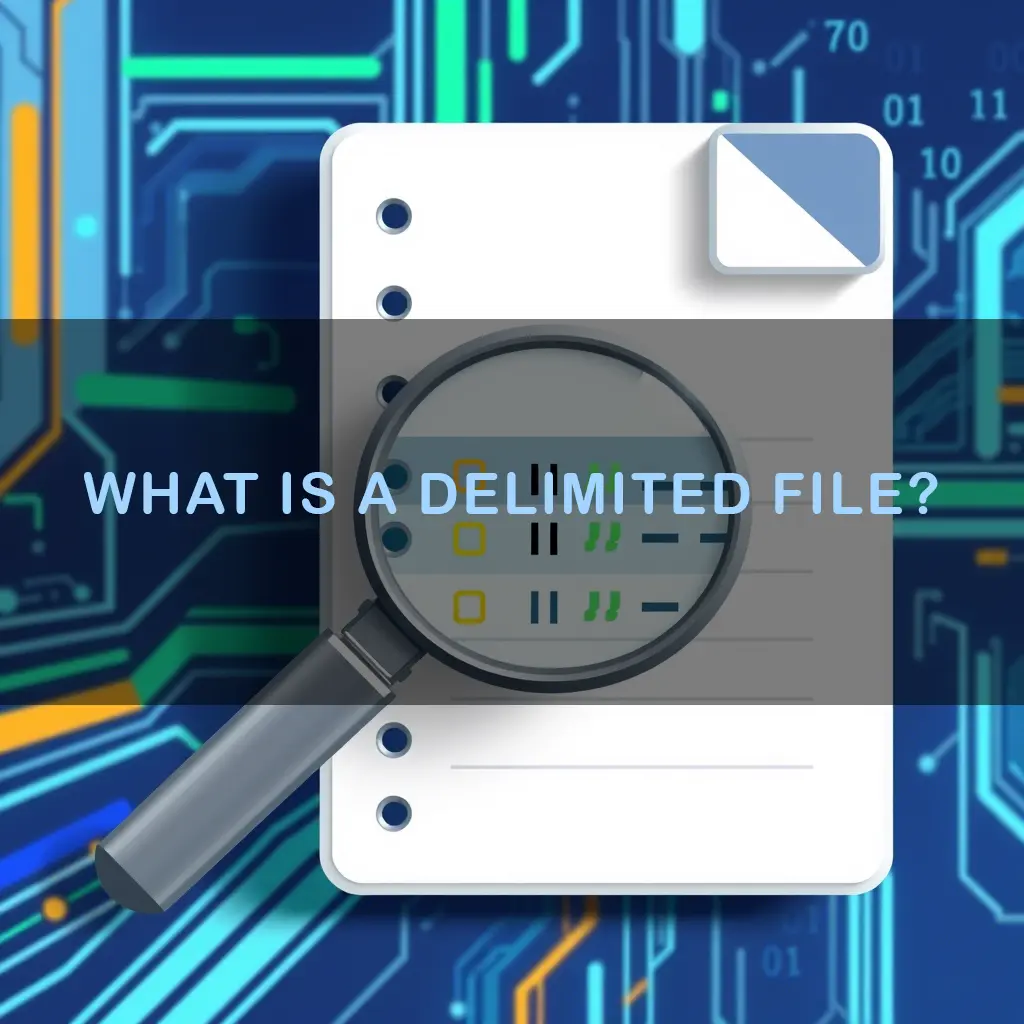“What is a Delimited File: A delimited file is a text file where data is separated by specific characters like commas, tabs, or pipes. Common types include CSV, tab delimited, and pipe delimited files. Used in Excel and databases, they store structured data efficiently.
If you’ve worked with spreadsheets, databases, or text-based data, chances are you’ve stumbled upon a “delimited file.” While they may not seem glamorous, these files are critical for organizing, sharing, and processing information efficiently. But What is a Delimited File, and why is it so widely used?
This guide will break down everything you need to know about delimited files. We’ll cover the different types of delimiters, various file formats, and real-world examples. Plus, we’ll introduce you to a free, easy-to-use tool to make managing your data a breeze.
Table of Contents
What is a Delimited File?
A delimited file is a text file that uses specific characters, called delimiters, to separate individual pieces of data within a row. This format is commonly used to store structured data, such as in spreadsheets or databases, and can be easily processed by programs like Microsoft Excel, Google Sheets, or coding languages like Python.

Common Delimiters
- Comma (,): Widely used in CSV files (Comma-Separated Values).
- Tab (↹): Used in Tab-Delimited Files, preferred for keeping data neatly aligned in text editors.
- Pipe (|): Found in Pipe-Delimited Files, often used in server logs and data integration tasks.
- Other characters: Semicolons (;), colons (:), or even custom characters are sometimes used as delimiters for specific applications.
Is a Delimited File the Same as a CSV?
Not necessarily. While all CSV files are a type of delimited file (comma-separated), not all delimited files use commas. For example, a tab-delimited file or pipe-delimited file functions similarly but uses different characters as separators.
CSV files are a common example. Learn what CSV comma-delimited format means.
Types of Delimited Files
Delimited file formats vary depending on the use case and data processing requirements. Here’s a closer look at the common types:
1. Comma Delimited File
A Comma Delimited File or CSV file is by far the most popular format. It separates data using commas (,), making it perfect for spreadsheets, databases, and importing/exporting data.
Example (Comma Delimited File):
“`
Name,Age,Location
Alice,30,New York
Bob,25,London
“`
2. Tab Delimited File
A Tab Delimited File separates data with tabs (\t). This format aligns data neatly in text editors for easier readability.
Example (Tab Delimited File):
“`
Name Age Location
Alice 30 New York
Bob 25 London
“`
3. Pipe Delimited File
A Pipe Delimited File uses vertical bars (|) to distinguish data fields. It’s commonly used in server environments or when other delimiters might conflict with the data content.
Example (Pipe Delimited File):
“`
Name|Age|Location
Alice|30|New York
Bob|25|London
“`
4. Custom Delimited File
For specific needs, some files use custom delimiters such as colons (:), semicolons (;), or even special symbols like hashes (#).
Example (Colon Delimited File):
“`
Name:Age:Location
Alice:30:New York
Bob:25:London
“`
Benefits of Using Delimited Files
Delimited files offer several advantages, especially for businesses and developers:
- Simplicity: Easy to create, read, and edit in text-based editors or applications.
- Compatibility: Supported by virtually all database systems, spreadsheet software, and programming languages.
- Storage Efficiency: Smaller file sizes compared to formats like JSON or XML.
- Flexibility: Works well across various systems and platforms.
How to Work with Delimited Files Efficiently
While the format is simple, managing large datasets can be tedious. This is where tools like Delimiter Tool come in handy.
Recommended Tool: Comma Separator Tool
This free delimiter tool simplifies working with any type of text-delimited file. Whether you need to convert columns to comma-separated values (CSV), switch between delimiter types, or format data for SQL or JSON applications, this tool does it in seconds.
Key Features of Comma Separator Tool:
- Supports multiple delimiters, including commas, tabs, pipes, and more.
- Intuitive interface with no sign-up required.
- Options to clean, copy, or export data in CSV or TXT formats.
How to Use It:
- Paste your data into the input field.
- Choose your desired delimiter (e.g., comma, pipe, tab).
- Click “Convert” and access a clean, formatted output.
Delimited vs Fixed Width: A Side-by-Side Comparison
| Feature | Delimited Format | Fixed Width Format |
|---|---|---|
| Structure | Uses characters (like commas or tabs) to separate fields | Each field occupies a set number of characters |
| Flexibility | Highly flexible and easy to edit manually | Requires strict formatting and alignment |
| Readability | Easy to read in text editors and spreadsheets | Harder to read without proper formatting tools |
| File Size | Usually smaller due to no padding | Can be larger due to fixed character spacing |
| Common Uses | CSV, TSV, log files, data exchange | Mainframe systems, legacy data, bank files |
What is a Space Delimited File?
A space delimited file uses spaces: "Name Age City". It’s simple but risky—spaces in names like “New York” can break the structure unless fields are fixed-width.
Why spaces? They’re basic but less reliable for complex data.
Delimited Text File vs CSV: Key Differences Explained
All CSV files are delimited text files, but not all delimited text files are CSVs. The delimited text file vs CSV distinction lies in the delimiter: CSVs specifically use commas, while a delimited file format can use tabs, pipes, or others. CSVs often include optional quotes around fields (e.g., “John Doe, Jr.”), which other formats skip.
Real-World Delimited File Examples
Here’s a delimited file example in action:
- CSV:
"Alice,30,Paris" - Tab:
"Bob\t25\tLondon" - Pipe:
"Eve|28|Tokyo"
These might store customer data in a CRM system, processed by software like Excel or Python.
FAQs About Delimited Files
What is a text delimited file?
A text-delimited file stores data in plain text, with each field separated by a specific delimiter character. Examples include CSV, tab-delimited, and pipe-delimited files.
What is a comma delimited file?
It’s a file where commas separate data fields. For instance, it’s the most common format for spreadsheets and is often used in databases and data sharing.
What is a tab delimited file?
A tab delimited file uses the tab character (\t) as its separator, ensuring precise alignment in text editors.
What is a pipe delimited file?
It’s a file format that uses the pipe (|) symbol as a delimiter to separate data fields, often used in server logs or coding environments.
Is a CSV file always comma delimited?
Yes, CSV files specifically use commas as their delimiter, but similar formats may use other characters (e.g., TSV uses tabs).
Can I convert between delimiter types?
Absolutely! Using tools like Comma Separator Tool, you can easily switch between delimiter types by pasting your data and selecting the desired format.
Why Delimited Files Remain Essential in Data Management
Delimited files are a timeless tool in the world of data management. They offer a universal format that is simple yet powerful, making them indispensable for businesses, developers, and researchers alike. Leveraging tools like Comma Separating Tool can enhance your productivity, allowing you to convert, manage, and share data with ease.
Whether you’re working on crafting SQL queries, preparing spreadsheets, or handling integrations, understanding and using the right type of delimiter is a skill worth mastering.
For more on formatting, check out resources like Microsoft Learn or Wikipedia.











